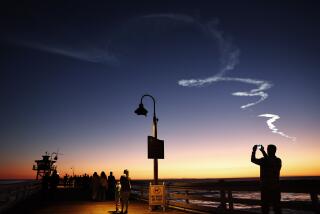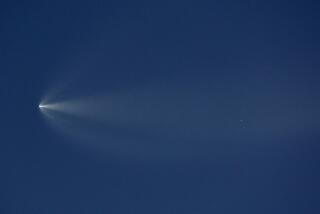Shuttle Ends Secret, Four-Day Military Mission : Space: The Atlantis lands at Edwards Air Force Base, but the public was not invited. It reportedly placed a spy satellite in orbit.
EDWARDS AIR FORCE BASE — Although few were on hand to witness it, the space shuttle Atlantis capped a secret, four-day military mission by swooping out of a windy but blue California sky Sunday morning to glide into a picturesque landing at this Mojave Desert base.
The shuttle, which had blasted off early Wednesday from the Kennedy Space Center in Florida, landed on time at 10:08 a.m. PST.
Sources have said that during its flight, the spacecraft placed in orbit a sophisticated photo-reconnaissance satellite designed to spy on the Soviet Union. NASA officials refused to confirm or deny this report.
For the most part, the NASA officials honored a Pentagon-imposed news blackout concerning the flight. They also refused to allow the public onto Edwards to view the landing. Only a few hundred NASA workers and invited guests, as well as reporters, were allowed to watch.
The mission apparently went well. “Congratulations on a great flight, guys, and welcome back,” was the message radioed by NASA officials to the five-man, all-military crew upon the shuttle’s return to Earth. And Atlantis pilot John H. Casper could be seen waving and giving a thumbs-up sign after the landing.
The 100-ton craft, the youngest of the three shuttles, signaled its arrival over Edwards with its characteristic twin sonic booms. Approaching from the northwest, Atlantis nearly circled the base before landing at more than 200 m.p.h. on Runway 23, a 5.2-mile-long clay strip on Rogers Dry Lake Bed.
The bleachers and viewing areas that typically hold thousands of spectators for open shuttle landings were empty Sunday. The craft appeared in good shape and the crew exited about 50 minutes after landing.
NASA officials, acknowledging that closed landings for military missions generate public complaints, said they plan to review that policy with defense officials. The result could be public viewing of future military shuttle landings, if the Pentagon agrees.
Adverse weather had threatened to delay Atlantis’ return Sunday, as rain was forecast and winds at times gusted above NASA limits. But no rain fell and, before the landing, the winds died down to head-wind gusts of 25 m.p.h., just under NASA’s threshold.
“Gorgeous,” said NASA spokeswoman Lisa Malone, after the shuttle, trailing a cloud of dust, rolled to a stop right on the black center line of the runway, having traveled 71 orbits around the Earth. NASA clocked the flight at 4 days, 10 hours and 18 minutes from start to touchdown.
Only two minor problems were reported as the shuttle descended toward Edwards. First, a circuit breaker on the craft was accidentally tripped, and then one of its hydraulic systems had a temporary drop in pressure. But NASA mission commentator Billie Deason said neither affected the landing.
The blastoff had not gone so smoothly. NASA had wanted to launch Atlantis on Feb. 22. But poor weather, a computer problem and a cold that afflicted mission commander John O. Creighton caused five postponements before Wednesday’s launch at 2:51 a.m. EST.
Atlantis’ mission was the 34th flight overall since the first shuttle flight in April, 1981. The mission was the sixth solely dedicated to a Department of Defense objective, NASA officials said. And it was the second shuttle flight this year, with seven more scheduled.
The shuttle Discovery is scheduled for an April 12 launch. Its mission is to place into orbit a $1.5-billion observatory designed to allow astronomers to study stars and galaxies so distant that their light has been traveling toward Earth for 14 billion years.
Along with Creighton, a Navy captain, and Casper, an Air Force colonel, the crew for the Atlantis flight consisted of mission specialists Marine Lt. Col. David C. Hilmers, Air Force Col. Richard M. Mullane, and Navy Lt. Cmdr. Pierre J. Thuot. All but Casper and Thuot had been on previous shuttle flights.
More to Read
Sign up for Essential California
The most important California stories and recommendations in your inbox every morning.
You may occasionally receive promotional content from the Los Angeles Times.










